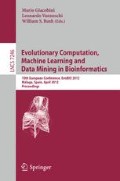Abstract
In the recent years many bio-inspired computational methods were defined and successfully applied to real life problems. Examples of those methods are particle swarm optimization, ant colony, evolutionary algorithms, and many others. At the same time, computational formalisms inspired by natural systems were defined and their suitability to represent different functions efficiently was studied. One of those is a formalism known as reaction systems. The aim of this work is to establish, for the first time, a relationship between evolutionary algorithms and reaction systems, by proposing an evolutionary version of reaction systems. In this paper we show that the resulting new genetic programming system has better, or at least comparable performances to a set of well known machine learning methods on a set of problems, also including real-life applications. Furthermore, we discuss the expressiveness of the solutions evolved by the presented evolutionary reaction systems.
Access this chapter
Tax calculation will be finalised at checkout
Purchases are for personal use only
Preview
Unable to display preview. Download preview PDF.
References
Caudill, M.: Neural networks primer, part i. AI Expert 2, 46–52 (1987)
Cristianini, N., Shawe-Taylor, J.: An introduction to support vector machines: and other kernel-based learning methods. Cambridge University Press (2000)
Ehrenfeucht, A., Rozenberg, G.: Basic Notions of Reaction Systems. In: Calude, C.S., Calude, E., Dinneen, M.J. (eds.) DLT 2004. LNCS, vol. 3340, pp. 27–29. Springer, Heidelberg (2004)
Ehrenfeucht, A., Rozenberg, G.: Reaction systems. Fundamenta Informaticae 75, 263–280 (2007)
Ehrenfeucht, A., Rozenberg, G.: Introducing time in reaction systems. Theoretical Computer Science 410, 310–322 (2009)
Fogel, D.B.: Evolving computer programs. In: Fogel, D.B. (ed.) Evolutionary Computation: The Fossil Record, ch. 5, pp. 143–144. MIT Press (1998)
Fogel, L.J., Owens, A.J., Walsh, M.J.: Artificial Intelligence through Simulated Evolution. John Wiley (1966)
Frank, A., Asuncion, A.: UCI machine learning repository (2010), http://www.ics.uci.edu/~mlearn/
Friedberg, R.M.: A learning machine: Part 1. IBM J. Research and Development 2(1), 2–13 (1958)
Hall, M., Frank, E., Holmes, G., Pfahringer, B., Reutemann, P., Witten, I.H.: The weka data mining software: an update. SIGKDD Explor. Newsl. 11, 10–18 (2009), http://www.cs.waikato.ac.nz/ml/weka/
Heckerman, D.: A tutorial on learning with bayesian networks. In: Innovations in Bayesian Networks. SCI, vol. 156, pp. 33–82. Springer, Heidelberg (2008)
Kantschik, W., Banzhaf, W.: Linear-Tree GP and Its Comparison with Other GP Structures. In: Miller, J., Tomassini, M., Lanzi, P.L., Ryan, C., Tetamanzi, A.G.B., Langdon, W.B. (eds.) EuroGP 2001. LNCS, vol. 2038, pp. 302–312. Springer, Heidelberg (2001)
Kantschik, W., Banzhaf, W.: Linear-Graph GP - A New GP Structure. In: Foster, J.A., Lutton, E., Miller, J., Ryan, C., Tettamanzi, A.G.B. (eds.) EuroGP 2002. LNCS, vol. 2278, pp. 83–92. Springer, Heidelberg (2002)
Koza, J.R.: Genetic Programming: On the Programming of Computers by Means of Natural Selection. MIT Press, Cambridge (1992)
Miller, J.F., Thomson, P.: Cartesian Genetic Programming. In: Poli, R., Banzhaf, W., Langdon, W.B., Miller, J., Nordin, P., Fogarty, T.C. (eds.) EuroGP 2000. LNCS, vol. 1802, pp. 121–132. Springer, Heidelberg (2000)
Montana, D.J.: Strongly typed genetic programming. Evolutionary Computation 3(2), 199–230 (1995)
O’Neill, M., Ryan, C.: Grammatical evolution. IEEE Transactions on Evolutionary Computation 5(4), 349–358 (2001)
O’Neill, M., Vanneschi, L., Gustafson, S., Banzhaf, W.: Open issues in genetic programming. Genetic Programming and Evolvable Machines 11, 339–363 (2010)
Orr, M.J.L.: Introduction to radial basis function networks. Technical report, Centre For Cognitive Science, University of Edinburgh, Edinburgh (1996)
Platt, J.C.: A fast algorithm for training support vector machines. Technical report, Microsoft Research, Redmond, USA (1998)
Poli, R., Langdon, W.B., McPhee, N.F.: A field guide to genetic programming (2008), http://lulu.com , http://www.gp-field-guide.org.uk (With contributions by J. R. Koza)
Rish, I.: An empirical study of the naive bayes classifier. In: IJCAI 2001 Workshop on “Empirical Methods in AI” (2001)
Teller, A., Veloso, M.: PADO: A new learning architecture for object recognition. In: Ikeuchi, K., Veloso, M. (eds.) Symbolic Visual Learning, pp. 81–116. Oxford University Press (1996)
Whigham, P.A.: Grammatical Bias for Evolutionary Learning. PhD thesis, School of Computer Science, University College, University of New South Wales, Australian Defence Force Academy, Canberra, Australia (October 14, 1996)
Author information
Authors and Affiliations
Editor information
Editors and Affiliations
Rights and permissions
Copyright information
© 2012 Springer-Verlag Berlin Heidelberg
About this paper
Cite this paper
Manzoni, L., Castelli, M., Vanneschi, L. (2012). Evolutionary Reaction Systems. In: Giacobini, M., Vanneschi, L., Bush, W.S. (eds) Evolutionary Computation, Machine Learning and Data Mining in Bioinformatics. EvoBIO 2012. Lecture Notes in Computer Science, vol 7246. Springer, Berlin, Heidelberg. https://doi.org/10.1007/978-3-642-29066-4_2
Download citation
DOI: https://doi.org/10.1007/978-3-642-29066-4_2
Publisher Name: Springer, Berlin, Heidelberg
Print ISBN: 978-3-642-29065-7
Online ISBN: 978-3-642-29066-4
eBook Packages: Computer ScienceComputer Science (R0)

